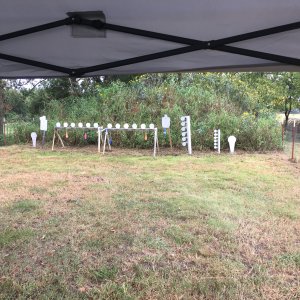Here is the basic method of making a great survival shelter than can be made in most places with nothing but bare hands, good effort and what the landscape provides.
A Debris Hut when made to the proper dimensions & depth will keep you comfortably warm in SUB bitter cold conditions & totally dry in a day after day down poor. And it can be made when standing naked in the woods with nothing practically as efficiently as if you had your “survival kit.†And it does not rely on any auxiliary heat source unlike the totally inefficient lean-to of outdoor lore does.
There are only two deal breakers for this shelter:
Size: SMALLER is better. We are using the word “shelter†but you need to be thinking more along the lines of “permanent, waterproof, immobile sleeping bag.†The only heater warming the square footage will be your tired, fatigued and hungry body. Do your body a favor by making the space it must warm the smallest feasible. Yes you can get away with a little roomier accommodation in summer (or maybe three seasons if you have managed to get lost with some warm gear. But anybody can manage with gear, the scope of this article is getting by pretty good “naked†or with â€"nothing.-)
Depth: of debris/insulation. Here is where I see the vast majority of students nullify the shelter as well as make a total waste of their overall effort. In a deciduous forest we use leaves as depicted in the following photographs. In other geographical areas you simply use the litter and duff found on the ground. Regardless of the material you use the most important part regarding your insulation material IS YOUR ARMPIT. I will teach you how to layout the arrangement and proportions of the frame in the coming pages- but let it sink in from the beginning that regardless of the insulation you use, it must be so deep at -A MINIMUM-, did you get that? MINIMUM, as in AT LEAST, as in MORE IS BETTER… that if you carefully worm you hand down into/through the insulation towards the underlying framework you quickly find yourself extended armpit deep into the debris but CAN’T reach/touch the frame with the tips of your fingers. You must have this much insulation +++ over the frame- at all points of the shelter.
Site:
It’s hard to describe the site one should choose for their primitive shelter and associated new home in The Great Lost. I see many armchair survivalists merely cut & paste text on how to go about picking the perfect “camp spot.†But we are not camping. We do not have three liters of water & a backpack full of calories. Also when was the last time a backpacker factored in “there’s a mother load of limbs and leaves on the ground here to use in shelter construction!†?
So the best I can boil it down to is to pick the greatest combination of several decent averages. For example: We don’t have the caloric surplus to hike all God’s creation to find a perfect spot. We don’t even have a container (made yet) to even put water in so we are better off to be in a so-so spot near a water source than in a perfect spot way away from water. Or there may be a ready made cave that is perfect and cozy, but it’s a killer of a scramble to get to it. Three trips in to our bed and we’re fresh out precious calories with no more in the pot. See? So we cannot afford for all the criteria of “the perfect spot†to be demanded. Use your head and go with the spot that offers the crude best of ALL averages.
Having said that there are ideal settings; the most overlooked is elevation. Middle elevation is ideal. Camp at the very lowest elevation next to your serene babbling brook and you will chill far quicker and burn all the more calories as the cold air descends and pools all around you during the night. And like every wanna-be â€expert†writer mentions- the danger of flash floods. Yes a true threat in a FEW areas, but it needs to be “touched on†not given it’s own entire chapter for Pete’s sake.
Camp on top and every venture & task results in all the more caloric burn as you head back UP to camp for every time you stepped away. Not to mention you’ll have less protection from the weather, be blasted by the wind and perhaps catch a widow maker (standing dead tree) with your sternum as you sleep away the wee hours of the night.
So middle elevation or good walking ground is ideal for our new Lost Camp.
In the survival situation you need to use the logic of the Trout. The typical places trout live is an environment of constant current. He is a master of judging caloric investment in regards to caloric return. He rests behind a rock in it’s calorie efficient eddy. With each morsel that he see’s coming his way he has to quickly decide if it is worth him kicking out into the full-on calorie consuming current to retrieve it, which will carry him down stream, only for him to have to kick back up to his calorie efficient eddy.
Now do you see, though you have been matching the hatch of #18 Adams flys coming off why your not catching anything? Simple- Your not offering him enough calories. You need to think not in dollar cost in this new life, rather calorie cost & caloric income.
The frame:
So you got your spot. You were wise to choose an area that had a decent natural cache of ready materials. The first thing you need to do is scribe you dimension in the ground. For this you will need a stylus. A pointed stick will fit the bill. Rake off the litter on the ground to bare dirt. This is a great time to remove any items that will torment your back during the night. Get centered up in your spot and sit down, legs crossed and straight out before you. Use your stick to scribe a line, right up against your body starting at your hip, down your legs around your foot and back up the hip on the opposite side. Now lie back and scribe as best you can around your torso to your shoulders. Finally with one arm stretched out as far as it can reach above your head scribe around that as best you can.


Next you will need a ridge pole long enough to more than cover the length of your scribed template. You will also need at least some forked branches to prop up the high end of the ridgepole. The ridge pole will be on the ground on one end and needs to be crotch high on the other. A crotch high stump or rock, etc. is really handy but not always around. So finding lying forked branches that can be broken to length is the norm and will suffice to elevate the upper end of the ridge pole.
In the following picture I have my ridgepole set up at the proper length and height.
Remember for the duration of this article and pictures, NO TOOLS nor “STORE BOUGHT STUFF†we’re used. For the creation of this shelter We used bare hands and what we picked up off the ground only. Not a knife, not a string, NADA.

Next we add on our ribbing. This is just upright sticks & heavy branches to add strength and to keep our insulation material from falling through. Make sure you stay just on the outer edge of your scribed line with the ribbing.

Lastly we add “lattice.†This is just (longer the better) fine sticks thrown over the heavy ribbing this way & that to further keep our insulation from poking through our framework. Think “woven wall†when adding the lattice but it is neither art nor needs to be a tedious task.
In the following picture you can see we started adding lattice.
[Note: this is not enough lattice really. And in the final picture there is not enough insulation. I recruited two willing child slaves from my neighborhood to help me build the shelter. They had to be home for a soccer game, and I did not get into the woods quite as early as I needed too to do the actual shelter to full scale. As I say, the great thing in a survival situation is at least you got plenty of time! ]

Lastly we pile UP (not “onâ€) our insulation material. Grab handfuls of litter from the floor of your area and carry it over to your frame. The trick is to pile it on from the bottom up. Sure you can hold it over the ridge and let it fall down, but this only makes progress deceptive and leads to skimping on quantity of insulation all the more.

So now we have a wind, water & cold proof shelter. But we need to add on the final fixins. If we attempt to sleep on the bare earth, all night long there will be a war of you trying to warm up planet earth, and earth trying to suck the heat out of your body. Guess who will win…every time? So at the least we need to PACK tight/solid the sleep area of the hut with more insulation material. I have slept warm & wooly this way several nights. I lay down with my feet pointing to the opening of the hut. I point my toes and do a little flutter kick while squirming my way into the CENTER of the packed insulation as best I can, opposed to worming in UNDER the insulation. This manner is “adequate.†You will not get hypothermia, but you’ll not be roasty toasty.
An upgrade is to line the floor of the sleep area with non compressable layer: bark & twigs over light limbs, etc. Establish a comfortable layer that will keep you entirely off the ground, if only a fraction of an inch. Then pack in your insulation and you’ll be comfortably warmso long as you did a good job.
The ultimate set up I have ever used was tall grass. I made a shelter and slept in it two nights made in the above format. While out exploring for groceries to eat and goods to make utilitarian items I discovered about a 1.5 or 2 acre patch or waist high grass. I pulled up three “bear hug†loads of the stuff and took it to my shelter. I sawed off the roots from the stems (with a jawbone & attached teeth I had found) and lined the floor of my shelter HEAVILY with the hollow stalks of the grass. I laid it “log cabin†style or warp & weft to you survival weavers. The overall grass floor mat was a full three inches thick & quite dense. Violin! All natural Dupont Hollowfil just like in a real sleeping bag. This was amazing. It was â€"totally- comfortable, and protected me from the ground so well I had to sleep in an EMPTY debris hut to keep from waking up hot.
If a person is creative and observant it is not hard to come up with a good insulating & comfortable floor mat such as this. Even a quarter bazillion little sticks & twigs tightly laid in lattice style would work amazingly well. Top that with a bazillion pine needles etc and you’ll be needing to vent your shelter to keep from being too hot.
And finally:
The door. Again the crudest door plug is a pile of insulation you drag over to plug the entire opening of your shelter as best you can once inside. A multi forked limb used as a rudimentary rake helps.
In the past I have propped up bark and rotted half sections of logs to form a door opening that I could barely slither through- these too of course covered to the pit in insulation material. This makes it all the more easier to completely seal the opening by dragging up a door plug.
My ultimate door I had ever made was where there was a downed tangle of poplar trees. Inner bark of poplar trees has an abundance of awesome fibers, [as well as giving up huge sheets of intact bark: think shelter, quivers, bowls, work sheds, crude clothing{buff the hound out of it} etc.]
I gathered a lot of fibers and basically made me a 3’ x 4’ net. I fixed one end of the net to the opening of the door. I pulled it out horizontally and propped it up on sticks. It kinda looked like a net awning on the side of a camper so to speak. On top of my net I piled A BUNCH of insulation materials. When I was in my hut for the night I would kick out the prop sticks dumping a mountain of insulation over my door sealing me in TIGHT & 100% draft proof for the night.
Again, not that you need to precisely repeat a grass bed or a net door, rather it’s just to illustrate that if you are creative and have a open mind you can fair far better than you’d initially think if you use what’s on hand.
Do take time to make you a full scale debris hut, and of course SLEEP IN IT!
Coming in the next chapter we will look at a couple ways of starting a friction fire. More to come.
A last note: Take a kid(s) into the woods, and teach them to shoot, fish,hunt, track, trap & rub sticks together for fire. Our heritage & subsequently our freedoms are being lost to Nintendo Wii (etc.)

Addendum:
Debris huts are wonderfully camouflaged. Sometimes this is a good thing. And with additional large limbs/small downed trees added on (in a self supporting way, don't mash the loft of your insulation) to further break up the moundish silhouette the things really do become invisible.
However, within the scope of this article, the average person would REALLY APPRECIATE being FOUND.
So it's a good idea to make large mobiles like over a baby's crib out of very bright materials and hang them all around your camp. In the naked theme, bright white wood works: poplar in my area. The movement of your mobiles in the wind are quite eye catching. IF you find trash/litter, polish any pieces you can with creek sand and make wind driven noise makers out of the others.
In a "kit" context: When I was search ground team commander I made all my guys carry a 50 cent K-Mart (I just dated myself) bright orange disposable poncho. The things were so frail I imagine rain would damage them, but they were "air weight" , took up practically no room in the ruck, and made great signal markers. Of course all our military gear blended in the woods nicely. But oddly enough there is a freakishly high incidence of the rescuer becoming a rescuee as well. The old saying is "if you don't want to get lost, stay on the trail." But EVERY searcher/rescuer must bushwack. And accordingly they get snake bit, injured & yes LOST.
So our SOP was to sit tight in shelter beneath a tree you wrapped your orange poncho around, and drum your time away on your pack frame or canteen- if it came to that.
So unless you don't want to be found, construct visual & audible attention getters. But you say, "I got a huge signal fire ready to torch, or I'll just walk up to them, or.." That's great, unless your dehydrated, hypothermic, snake bit or ______ and practically comatose in your invisible mound when the rescuers pass through.
____________
Article Source







